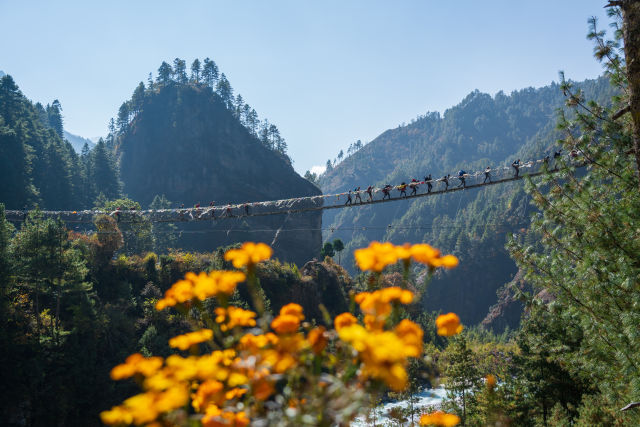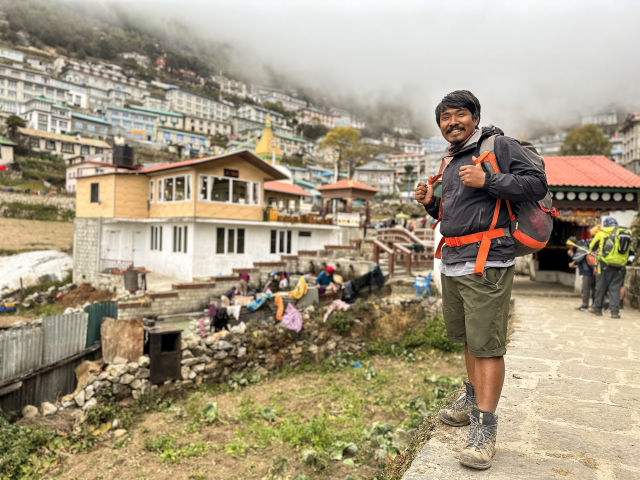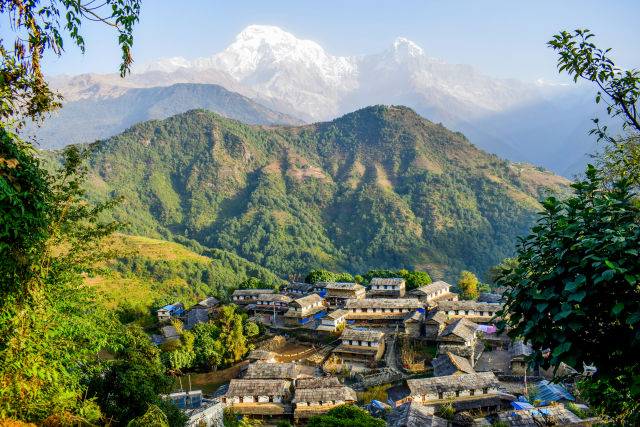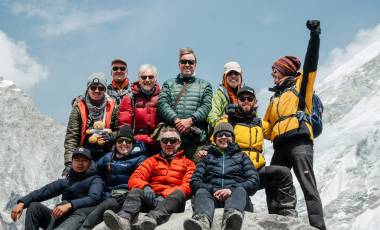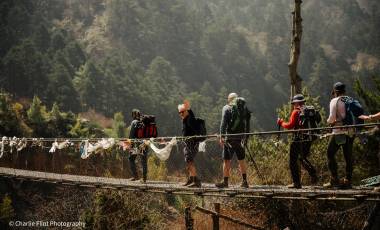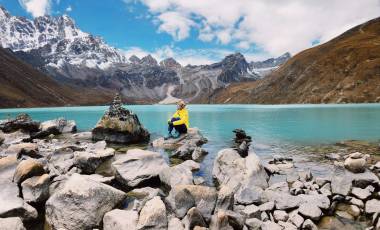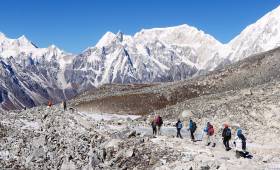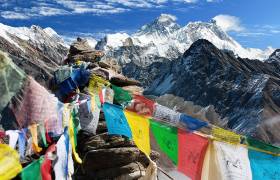Absolutely amazing trip from start to finish. Met at the airport by a smiling Tenzi Sherpa, couldn’t have had a more welcoming greeting. Thorough briefing before an early start off into the mountains. Kept fully informed all the way along the trek. Always kept upbeat by Tenzis ready smile and laugh.
Stunning scenery and totally awe inspiring to walk among the highest mountains in the world.

Everest Base Camp Treks
Top 5 Mount Everest Trekking Highlights
Our Everest Base Camp Tours
Embark on an unforgettable journey to Everest, where every step unveils breathtaking panoramas and cultural wonders. For many, Everest Base Camp is the ultimate trekking goal, other than taking on Sagarmāthā herself. The classic Everest Base Camp trek in Nepal is a demanding climb but not technical, making it the perfect challenge for ambitious hikers. At nearly 18000 feet, Base Camp is the starting point for many of the expeditions to take on the summit – look out for our special Expedition Departures in April for the chance to stay at Base Camp alongside the teams preparing for their summit attempt.
Immerse yourself in the rich tapestry of Sherpa culture as you traverse the rugged landscapes of the Thame Valley, where ancient monasteries cling to cliff faces amidst pristine alpine scenery. As you traverse the iconic trails, you’ll encounter iconic landmarks such as Kala Pattar, offering unrivaled vistas of Everest’s summit, and delve into hidden gems like the serene Gokyo Valley, where turquoise lakes mirror the towering peaks above. Challenge yourself with thrilling ascents over high mountain passes like the formidable Cho La and the Renzo La, where every step is rewarded with awe-inspiring vistas of snow-capped peaks stretching into the horizon. Led by experienced local guides, our treks ensure both safety and authenticity, allowing you to fully embrace the spirit of adventure while forging deep connections with the land and its people.
Whether you’re a seasoned trekker or a novice adventurer, our best Everest Base Camp treks offer an unparalleled opportunity to explore one of the world’s most iconic destinations. Join us and unlock the wonders of the Himalayas, where every trail tells a story and every vista leaves you breathless.
Our Best Everest Base Camp Treks
Stephanie Tugwell Everest Base Camp Trek
Anna Lastuvkova Everest Base Camp TrekEverest Base Camp is a trip to remember. Starting in the bustling city of Kathmandu where you get the first impressions of Nepal. Hot and busy.
Followed by evening briefieng where you meet your group for the first time. Early morning start with the biggest adventure of getting on a small plane to Lukla 😀 Yes, the trails to Base camp can get busy. We were quite lucky that despite the busy season in April, we still had good amount of time walking alone as a group and passing others at the teahouses. The trek itself is not difficult. The pace is very slow to make sure you acclimatise well, but be prepared for long days of walking -albeit very slowly. We were so lucky to have clear skies coming up and the views were breathtaking. From the first time you get to see Mount Everest to being surrounded by the changing landscape of 6000+ metre giants. All of us made it to Base Camp together after 8 days of ups and downs. It really is an unforgettable trip and for me so much more about the journey itself, rather than stepping your foot in EBC. You get used to the life in the valley, locals, animals passing by, beautiful monasteries and everpresent prayer flags. Food is quite tasty and mostly carbs, which we all appreciated the colder it got. We were so well taken care of by our leader and guides and big thank you goes to them for making us safe and always well fed and happy 🙂
If you love mountains, I can only recommend this trip.
Terry Saul Everest & Gokyo Lakes CircuitThis was my first time walking in the Himalayas and it was a truly magical experience. The scenery was breath-taking. I am glad we chose the route taking in Gokyo and the Cho La pass which were both challenging and beautiful and made for quieter days on the trail than when we got back to the main base camp route, which was considerably busier. We had not stayed in teahouses before and they made a change from the experience in tents we had previously, but the lack of variety in food menus did mean we ate the same things many days.
FAQs on Everest Base Camp Tour
How physically fit do I need to be to complete the trek?
A good level of fitness is recommended for trekking to Everest Base Camp, as it involves long days of walking and altitude gains. Trekkers should be prepared for physical exertion and be able to walk for several hours each day. For more details on how to prepare, check your trip notes and our fitness guide.
What type of accommodation can I expect on my Everest Base Camp trek?
Accommodations along the trekking route are typically basic tea houses or lodges, usually offering shared sleeping quarters and communal dining areas. Amenities may vary, but they provide a comfortable resting place after a day of trekking, and often offer stunning mountain views and provide an authentic local experience.
The main trekking season in Nepal typically runs from October to mid-May, offering comfortable daytime temperatures and clear skies for much of the time. Daytime temperatures vary from 59°F to 95°F in the Kathmandu Valley, gradually decreasing from there with altitude. Different seasons provide distinct advantages for trekking:
- Post-monsoon/autumn (Mid-September to November) offers sunny and mild days with clear mountain views, although nights can be cold, especially at higher altitudes.
- Winter (December to end of February) brings clear skies and the best mountain views, with colder nights but pleasant, sunny days and fewer crowds on the trails.
- Pre-monsoon/spring (March to May) features warmer temperatures and blooming flowers, although haze may develop in the afternoons and temperatures can soar in the lowlands.
Snow should be expected at higher altitudes on any departure, and travelers should always be prepared for unpredictable weather conditions in the mountains.
Exodus has been operating Everest tours for over 30 years, providing trekkers with a wealth of experience and expertise. Our award-winning team of local guides is handpicked for their extensive knowledge of the trails, ensuring a safe and enjoyable trekking experience. Each guide is not only qualified in first aid but also undergoes rigorous training to recognize and manage symptoms of altitude sickness, a common concern when trekking at high elevations.
Each guide’s deep understanding of the terrain, weather patterns, and local customs enhances the overall journey, allowing trekkers to immerse themselves fully in the adventure while feeling confident in their guides’ abilities. Whether navigating challenging mountain passes or sharing insights into the region’s culture and history, our guides are dedicated to providing trekkers with an unforgettable and enriching experience in the Himalayas.
As with any trek, appropriate footwear and sun protection are essential. Additionally, duffle bags or soft kit bags are required for the porters to carry on trek, and there are weight limits in place for the regional flights. Check your trip notes and our Everest Region Kit List for more detailed and specific packing information. By ensuring you have the necessary gear and equipment and following packing guidelines, you’ll be well-prepared to embark on the unforgettable journey to Everest Base Camp while staying comfortable and safe throughout the trek.
When embarking on a mountain trek, it’s essential to be prepared for a wide range of temperatures and weather conditions. The best approach to clothing is to layer up with multiple thin layers rather than relying on a few thick items of heavy clothing. Thin layers are easier to adjust as the temperature fluctuates throughout the day and provide better insulation against the cold.
Nepalis often adhere to traditional dress norms, so it’s advisable for trekkers to dress conservatively out of respect for local customs. This means avoiding sleeveless tops or revealing clothing that may be considered inappropriate in more traditional communities. While shorts are generally acceptable for both men and women, they should be modest and reach to just above the knee. For women, a skirt or trousers are preferable options, particularly in areas where traditional attire is more common.
Altitude sickness prevention measures include acclimatization days built into the itinerary, gradual altitude gains, and experienced guides trained to recognize and manage symptoms of altitude sickness. Additionally, trekkers are advised to stay hydrated, ascend slowly, and listen to their bodies.
Expert Blog Entries
The Adventure Begins Here
Get regular inspiration straight to your inbox from Exodus’ experts.


